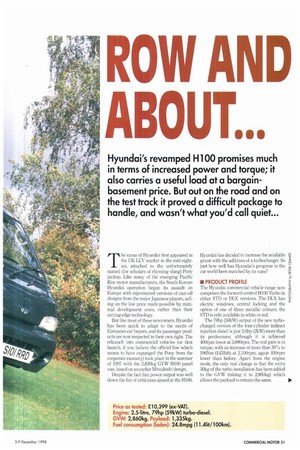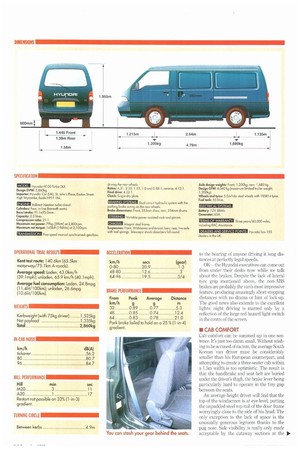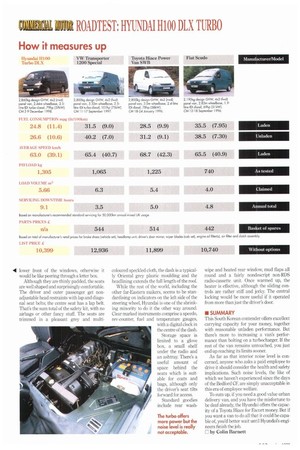ROW AND
Page 33

Page 34

Page 35

Page 36

If you've noticed an error in this article please click here to report it so we can fix it.
Hyundai's revamped H100 promises much in terms of increased power and torque; it also carries a useful load at a bargainbasement price. But out on the road and on the test track it proved a difficult package to handle, and wasn't what you'd call quiet...
PHOTOGRAPHY by PETER CRAMER
he name of Hyundai first appeared in the UK LCV market in the mid-eighties, attached to the unfortunately named (for scholars of rhyming slang) Pony pickup. Like many of the emerging Pacific Rim motor manufacturers, the South Korean Hyundai operation began its assault on Europe with rejuvenated versions of cast-off designs from the major Japanese players, selling on the low price made possible by minimal development costs, rather than their cutting-edge technology.
But like most of these newcomers. Hyundai has been quick to adapt to the needs of European car buyers, and its passenger products are now respected in their own right. The relaunch into commercial vehicles (or first launch, if you believe the official line which seems to have expunged the Pony from the corporate memory) took place in the summer of 1997 with the 2,830kg GVW HI 00 panel van, based on an earlier Mitsubishi design.
Despite the fact that power output was well down the list of criticisms aimed at the H100, Hyundai has decided to increase the available grunt with the addition of a turbocharger. So just how well has Hyundai's progress in the car world been matched by its vans?
• PRODUCT PROFILE The Hyundai commercial vehicle range now comprises the forward-control WOO Turbo in either STD or DLX versions. The DLX has electric windows, central locking and the option of one of three metallic colours; the STD is only available in white or red.
The 79hp (59kW) output of the new turbocharged version of the four-cylinder indirect injection diesel is just 2.6hp (2kW) more than its predecessor, although it is achieved 400rpm lower at 3,600rpm. The real gain is in torque, with an increase of more than 30% to 196Nm (145lbft) at 2,100rpm, again 400rpm lower than before. Apart from the engine mods, the only real change is that the extra 30kg of the turbo installation has been added to the GVW (taking it to 2,8601(g) which allows the payload to remain the same.
41 The Hyundai's frontal styling can most kindly be described as individual, although the bulbous nose does provide more of a crumple zone than some forward-control vans. While the van looks like it should have an opening bonnet, this is just a trick from the stylist's pencil. And the designers must have spent ages on the exquisitely detailed rear lights, which makes it all the more of a shame that they forgot to include a rear fog light, ending up with an afterthought: a car-boot sale job dangling vulnerably under the bumper just like a grey import.
II PRODUCTIVITY In theory, at least, the Hyundai offers a very good payload, and it is a rarity in having a lower kerb weight than claimed by its maker. Unfortunately, with a perfectly distributed load at maximum GVW, you have just 10kg to spare on each axle—a nice trick if you can guesstimate it, but if you intend to get the best from it, you'd better buy your own weighbridge!
Access to the load space is through a tailgate incorporating an outward bulge, which gives a little extra headroom when open, or through the left-hand sliding door. The tailgate has a light in its lower half which illuminates the floor from overhead when open. A nice touch. Despite the side door's apparently generous height, the floor is significantly higher than the door bottom, requiring some caution if a bump on the head is to be avoided while getting into the back, and the door's width of 880rnm prevents the side loading of a UK standard pallet. Fortunately, if small packages are carried, almost all the loadspace is in easy reach from the side or rear doors.
The load space length, an apparently generous 2,370mm, is somewhat reduced by the engine's bulge behind the steel half-height bulkhead, which is topped by a sturdy tiedown rail. The upper body sides carry double protection rails. A fully-fitted load mat and six tie-down points also come as standard; trim panels are fitted up to waist height. (9.41it/100km) to impress CM—and the H100's 24.8mpg (11.4lit/100km) doesn't do the trick.
Access to the engine simply entails releasing two catches and lifting the whole of the passenger seat and floor upwards—just as well, as the van needs a service every 4,500 miles, A careful search for the fuel filler flap's release lever ended in defeat—the hand book eventually revealed its position, tucked away behind the handbrake.
II ON THE ROAD Hyundai executives of a nervous disposition might want to skip this section. Truth to tell, the greatest impact of that 30% torque hike is to raise the surplus of power over grip to an embarrassing degree, despite the soft suspension. How much of this deficit in the traction stakes is down to the 185R14 Hanka* tyres is debatable, The suspension gives a comfortable ride and good bump absorption, but it's underdamped and wallowy. Stop-start motoring soon gives way to a nasty dose of nodding-dog syndrome.
Comfort aside, the worst aspect of the suspension characteristics is a distinct sensitivity to cross winds. In slightly windy conditions, where no other vehicles seem to be having trouble, the Hyundai is already becoming a handful. When conditions deteriorate further, the Korean van becomes downright scary—it feels like driving on ice. The variable-rate power steering is reasonably sharp, but is just about as light as it can get away with.
Unfortunately it gets worse. The in-line four cylinder engine, located under the seats, sounds strangely like a flat-four Subaru or similar. The sound is not unpleasant, there's just far too much of it. But the transmission noise could never be described as pleasant. It whines, almost to the extent of sending us in search of some sawdust, and it clunks on each reversal of torque. The ratios themselves are well matched, but the gearchange might best be described as feeling like a hot knife through wet concrete.
We recorded a horrific 84,7dR(A) of cab noise at a constant 60mph on our usual test track. Add in the radio and heater blower, and the Hyundai is likely to present a genuine risk to the hearing of anyone driving it long distances at perfectly legal speeds.
OK-the Hyundai executives can come out from under their desks now while we talk about the brakes. Despite the lack of lateral tyre grip mentioned above, the non-ABS brakes are probably the van's most impressive feature, producing amazingly short stopping distances with no drama or hint of lock-up. The good news also extends to the excellent lights: night driving is marred only by a reflection of the large red hazard light switch in the centre of the screen.
• CAB COMFORT Cab comfort can be summed up in one sen. tence. It's just too damn small. Without wishing to be accused of racism, the average South Korean van driver must be considerably smaller than his European counterpart, and attempting to create a three-seater cab within a 1.5m width is too optimistic. The result is that the handbrake and seat belt are buried under the driver's thigh, the brake lever being particularly hard to operate in the tiny gap between the seats.
An average-height driver will find that the top of the windscreen is at eye level, putting the unpadded steel top rail of the door frame worryingly close to the side of his head. The only exception to the lack of space is the unusually generous legroom thanks to the pug nose, Side visibility is really only made acceptable by the cutaway sections at the • lower front of the windows, otherwise it would be like peering through a letter box. Although they are thinly padded, the seats are well shaped and surprisingly comfortable. The driver and outer passenger get nonadjustable head restraints with lap and diagonal seat belts; the centre seat has a lap belt. That's the sum total of the safety kit, with no airbags or other fancy stuff. The seats are trimmed in a pleasant grey and multi coloured speckled cloth, the dash is a typically Oriental grey plastic moulding and the headlining extends the full length of the roof.
While the rest of the world, including the other far-Eastern makers, seems to be standardising on indicators on the left side of the steering wheel, Hyundai is one of the shrinking minority to do it the other way around. Clear marked instruments comprise a speedo, rev-counter, fuel and temperature gauges, with a digital clock in the centre of the dash.
Storage space is limited to a glove box, a small shelf under the radio and an ashtray. There's a useful amount of space behind the seats which is suitable for coats and bags, although only the driver's seat tilts forward for access.
Standard goodies include rear wash wipe and heated rear window, mud flaps all round and a fairly nondescript non.RDS radio-cassette unit. Once warmed up, the heater is effective, although the sliding controls are rather stiff and jerky The central locking would be more useful if it operated from more than just the driver's door.
• SUMMARY
This South Korean contender offers excellent carrying capacity for your money, together with reasonable unladen performance. But there's more to increasing a van's performance than bolting on a turbocharger. lithe rest of the van remains untouched, you just end up reaching its limits sooner.
As far as that interior noise level is concerned, anyone who asks a paid employee to drive it should consider the health and safety implications. Such noise levels, the like of which we haven't experienced since the days of the Bedford CF, are simply unacceptable in this era of employee welfare.
To sum up, if you need a good value urban delivery van, and you have the misfortune to be deaf already, the Hyundai offers the capacity of a Toyota Hiace for Escort money. But if you want a van to do all that it could be capable of, you'd better wait until Hyundai's engineers finish the job.
CI by Colin Barnett Price as tested: £.10,399 (ex-VAT).
Engine: 2.5-litre, 79hp (59kVV) turbo-diesel.
GVW: 2,860kg. Payload: 1,335kg. Fuel consumption (laden): 24.8mpg (11.41it/100km).
SPECIFICATION
EMI Hyundai H100 Turbo DLX.
Design GVW: 2,860kg.
Importer: Hyundai Car (UK), St..(ohn's Place, Easton Street, High Wycombe, Bucks HP11 1Ni.
Mril Indirect-injection turbo-diesel.
Cylinders: Four, in-line (beneath seats).
Bore/stroke: 91.1x95.0mm.
Capacity: 2.5 litres.
Compression ratio: 21-: I .
Maximum net power: 79hp159kW} at 3,800rpm. Maximum net torque: 145164(196Nm) at 2,100rpm.
MEE= Five-speed manual synchromesh gearbox, driving the rear wheels.
Ratios: 4.31,2.33 1,53, 1,0 and 0.88:1; reverse, 4.12:1. Final drive: 422:1.
Clutch: Single dry plate Dual-circuit hydraulic system with the parking brake clang on the rear wheels.
Brake dimensions: Front, 253mm discs; rear, 254mm drums. BRAKING SYSTEMS: MIME Variable-power-assisted rack-and-pinion.
Mtn Integral steel frame.
Suspension: Front, Wishbones and torsion bars, rear, live axle with leaf springs. Telescope shock absorbers fall round.
Axle design weights: Front, 1,200k9; rear, 1,680 kg. Design GTW: 4,060 kg (maximum braked trailer weight, 1,200kg).
Wheels and tyres: 5 0.(xl Ain steel wheels with 185R14 tyres. Fuel tank: 55 litres.
MEIMEREMEMI Battery: I 2V, 88Ah. Generator: 65A.
TERMS OF WARRANTY Three years/60,000 miles, including RAC Ass(stance.
nEMMINESTENEffli Hyundai has 155 dealers in the UK.
OPERATIONAL TRIAL RESULTS
Kent test route: 140.6km (65.5km motorway/75.1km A-roads).
Average speed: Laden, 63.0km/h (39.1mph); unladen, 65.9 km/h (40.1mph).
Average fuel consumption: Laden, 24.8mpg (11.4)4/100km); unladen, 26.6mpg (10.6)it/100km).
ACCELERATION km/h secs [gear)
0-80 20.9 1-3
48-80 12.6 3 64-96 19.5 3/4 WEIGHTS Kerbweight (with 75kg driver) 1,525kg Net payload 1,335kg Total 2,860kg BRAKE PERFORMANCE From Peak Average Distance km/h g 9 m 32 0.89 0.77 5.3 48 0.85 0.74 12.4 64 0.83 0.78 21.0 Park brake failed to hold on a 25 % (1-in-4) gradient.
IN-CAB NOISE km/h dB(A) tickover 56.2 80 80.7 96 84.7 HILL PERFORMANCE Hill min sec M20 3 11
A20 1 17
Restart not possible on 33% (1-in-3) gradient.
TURNING CIRCLE Between kerbs 4.9m






















































































































